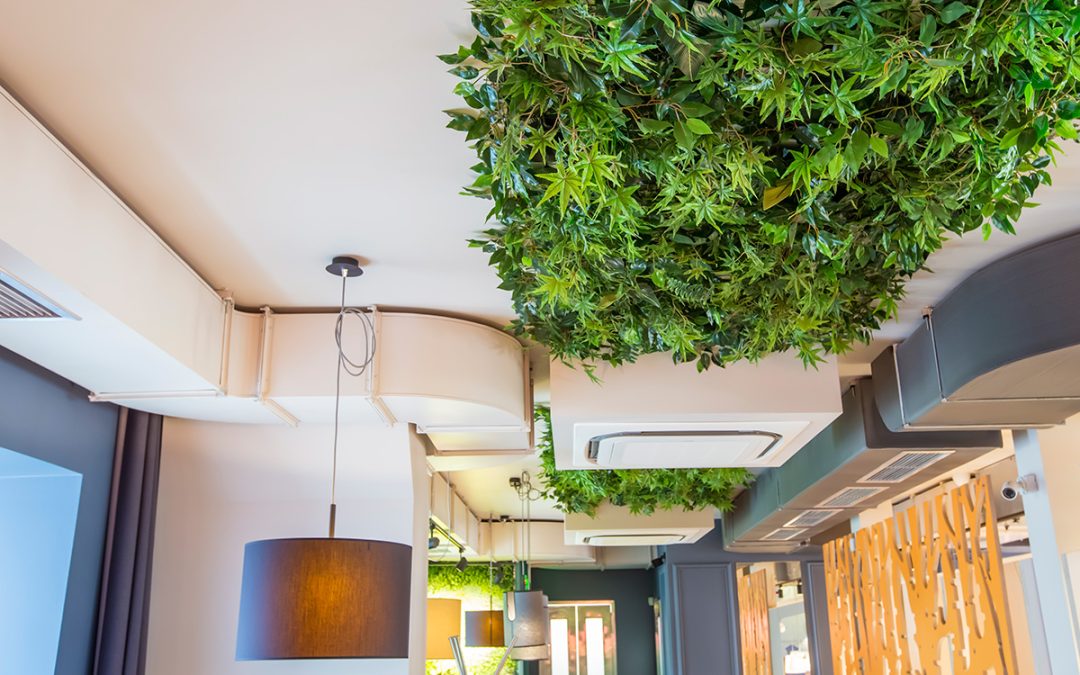Biophilic design is an approach to architecture and interior design that integrates natural elements into built environments to promote well-being and enhance the human experience. Rooted in the concept of biophilia—the innate human connection to nature—this design philosophy goes beyond aesthetics to create spaces that foster health, creativity, and productivity.
Biophilic design encompasses a wide range of elements and strategies, from incorporating living plants to using natural materials and mimicking natural patterns. Below are some key examples of biophilic design elements and how they are applied across various spaces.
1. Greenery and Plant Life
One of the most recognizable elements of biophilic design is the inclusion of greenery. Plants are not only visually appealing but also improve air quality, reduce stress, and create a calming atmosphere.
Examples:
- Indoor Plants: Adding potted plants to desks, shelves, and corners creates a vibrant, living workspace.
- Living Walls: Vertical gardens or “green walls” are popular features in offices, hotels, and public spaces. These walls are covered with a variety of plants, creating a striking and functional display.
- Rooftop Gardens: Transforming rooftops into green spaces provides employees or residents with outdoor areas for relaxation and socialization.
2. Natural Light
Access to natural light is a cornerstone of biophilic design. Sunlight has been proven to improve mood, regulate circadian rhythms, and enhance productivity.
Examples:
- Large Windows: Installing floor-to-ceiling windows maximizes natural light and provides expansive views of the outdoors.
- Skylights: These allow light to filter into spaces that might otherwise be dark or enclosed.
- Light Shelves: Reflective surfaces placed near windows bounce natural light deeper into a room, reducing the need for artificial lighting.
3. Water Features
Water elements add a sensory dimension to biophilic design, offering visual, auditory, and tactile stimulation that mimics natural environments.
Examples:
- Indoor Fountains: Small water features create soothing sounds that reduce stress and enhance focus.
- Aquariums: Incorporating aquariums into office spaces or waiting rooms provides a tranquil focal point.
- Reflecting Pools: Shallow pools with still water add elegance and a sense of calm to lobbies or courtyards.
4. Natural Materials
Using materials derived from nature connects people to the outdoors and fosters a sense of warmth and authenticity.
Examples:
- Wood: Hardwood floors, wooden furniture, and exposed beams are timeless biophilic design elements.
- Stone: Incorporating stone in countertops, walls, or flooring adds texture and durability.
- Bamboo and Cork: These sustainable materials are ideal for flooring, paneling, or decorative accents.
5. Nature-Inspired Patterns and Textures
Biophilic design often mimics the forms, patterns, and textures found in nature, even when natural materials are not directly used.
Examples:
- Biomorphic Patterns: Incorporating leaf-like or wave-like designs in textiles, wallpapers, and artwork.
- Organic Shapes: Furniture with rounded edges or irregular forms inspired by nature’s curves.
- Textures: Surfaces that mimic tree bark, sand, or stone provide a tactile connection to nature.
6. Views of Nature
Being able to see nature, even from within a building, has a significant impact on well-being and productivity.
Examples:
- Window Views: Designing workstations or seating areas to face gardens, trees, or water bodies.
- Atriums: Central spaces with open ceilings and plant life create a feeling of openness and connection to the outdoors.
- Perched Vistas: Elevating seating areas to overlook natural landscapes.
7. Dynamic and Diffuse Lighting
Light in nature constantly changes throughout the day. Mimicking these variations in indoor spaces creates a dynamic and engaging environment.
Examples:
- Adjustable Lighting: Incorporating lighting systems that change intensity and color temperature to reflect natural daylight cycles.
- Diffused Light: Using translucent materials to soften light and reduce harsh shadows.
- Natural Shadows: Creating shadow play with plants or textured glass to evoke the patterns of sunlight filtering through trees.
8. Airflow and Ventilation
Natural ventilation connects indoor spaces with the outdoors, improving air quality and enhancing comfort.
Examples:
- Operable Windows: Allowing fresh air to flow into the building.
- Cross-Ventilation: Designing spaces to encourage natural airflow between rooms or zones.
- Ceiling Fans: Mimicking the feel of an outdoor breeze.
9. Outdoor Spaces
Integrating outdoor areas into building design fosters a direct connection with nature and encourages outdoor activity.
Examples:
- Balconies and Terraces: Providing spaces for employees or residents to step outside.
- Courtyards: Central open-air spaces surrounded by buildings, often with plants, seating, and water features.
- Walking Paths: Outdoor paths lined with greenery encourage movement and relaxation.
10. Multi-Sensory Design
Biophilic design engages all the senses, creating a holistic and immersive experience.
Examples:
- Natural Sounds: Incorporating soundscapes of birdsong, water, or rustling leaves.
- Natural Scents: Using essential oils or materials like cedar and eucalyptus to evoke the smells of nature.
- Tactile Surfaces: Incorporating textures that feel natural, such as smooth stone or rough wood.
11. Refuge and Prospect Spaces
Biophilic design incorporates spatial configurations that mimic natural habitats, offering areas for both retreat and expansive views.
Examples:
- Refuge Spaces: Cozy nooks or private booths where individuals can relax or focus.
- Prospect Views: Open areas with broad views, such as lounges near windows overlooking landscapes.
12. Sustainability and Integration
Biophilic design often goes hand in hand with sustainable practices, reducing environmental impact while enhancing the connection to nature.
Examples:
- Green Roofs: Rooftops covered with vegetation reduce heat absorption and improve insulation.
- Rainwater Harvesting: Collecting and reusing rainwater for irrigation or water features.
- Recycled Materials: Using repurposed wood, metal, or glass to create eco-friendly designs.
Conclusion
Biophilic design elements bring the restorative power of nature into our daily lives, improving mental health, fostering creativity, and promoting physical well-being. Whether through greenery, natural light, water features, or organic materials, these elements create harmonious spaces that benefit individuals and communities alike. As we continue to prioritize sustainability and wellness, biophilic design serves as a timeless reminder of the profound connection between humans and the natural world.

